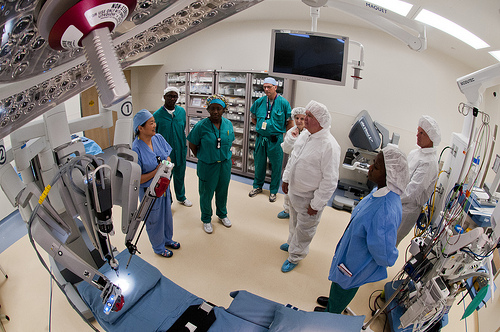Medical technology has changed the way we live, work, and do business. Today, a soldier can lose a leg in combat and, within a couple of years, have full mobility back using various prosthetic limb options. Pacemakers, artificial hearts, and all sorts of other technology have dramatically affected us for the better.
Today’s medical technology relies heavily on computers and computer technologies. Some of the most advanced medical equipment used by doctors, hospitals, and other health care professionals have embedded computer chips that allow our providers to do amazing things, and with amazing precision.
Here are some of the more exciting computer-based medical technologies in use today, and how they’re being used to keep us alive:
This is one of the most exciting medical devices to appear on the marketplace, and it wouldn’t be possible without embedded computers. This robotic arm is designed specifically for the purpose of knee replacement surgery.
In years past, doing knee replacement surgery meant many aggressive cuts on the knee. This would cause a long recovery time, as well as a significant amount of bleeding. This device, instead, gives the surgeon a robotic arm that allows her to precisely place a custom implant in a patient’s knew.
The MAKOPlasty Orthopedic System creates only a four to six inch incision in the knee. This greatly reduces the amount of bleeding, speeds up recovery, and reduces the risk of infection formerly faced by knee replacement patients.
Imaging technology used before the surgery helps to remove guesswork from the procedure. The imaging process isolates the bone from the soft tissue, and gives the surgeon a perfect view of what he’s going to be working with.
The da Vinci is another robotics-based surgical system that relies on computer technology to operate. The benefit, of course, of these types of devices is that they help to eliminate the possibility of human error during a surgical procedure, and allow a surgeon to make very exact and very precise movements and placements.
The da Vinci is used, primarily, for laparoscopic surgery in three specific areas: prostate procedures, hysterectomies, and colon or rectal surgery. This has resulted in a higher level of patient satisfaction and a greater degree of patient care. The minimally-invasive, computer-controlled robot leads to less loss of blood, faster recovery, and more.
This computer-based scanning device lets medical professionals have a much more accurate view of tumors and surgical sites. It allows surgeons to track the movements they make in key areas such as the sinuses, the brain, and the spine.
The system relies on an infrared camera as well as tracking software to help guide the surgeon during an operation. Because these surgeries take place within just millimeters of the brain and potentially the eyes, there are significant risks. Stryker gives surgeons the ability to do what needs to be done without major risk of brain damage.
When a person has a cardiac event relating to low blood flow – including heart attack or stroke – one of the best treatments is therapeutic hypothermia. The Arctic Sun Temperature Management System cools the body using gel cooling pads. This helps to slow brain inflammation, reduce brain damage, and decrease recovery time. Patients will stay in a cooled state for as long as 24 hours, depending on the nature of the injury and how the patient is responding.
This device can increase the chances of a full recovery from a stroke by as much as 35 percent. The goal, of course, is to see patients leave the hospital with no brain damage, allowing them to lead a normal life after they leave the hospital.
When it comes to strokes, the speed of response can make all of the difference. This system allows medical providers to give accelerated neuroligocal care to a stroke patient in real time, all day every day. Even if the stroke victim isn’t in a patient room, they can receive expedited care and treatment in the form of orders for Visiting Nurses, remote diagnostics, and new prescriptions.
Technology has plenty of potential for good in this world. Embedded computer technology is allowing us to do things today that we would have only dreamed about just 30 or 40 years ago. As time goes on, we’ll only see more and more advanced implementations of this technology, all of which will serve to extend our lives and increase its quality.
